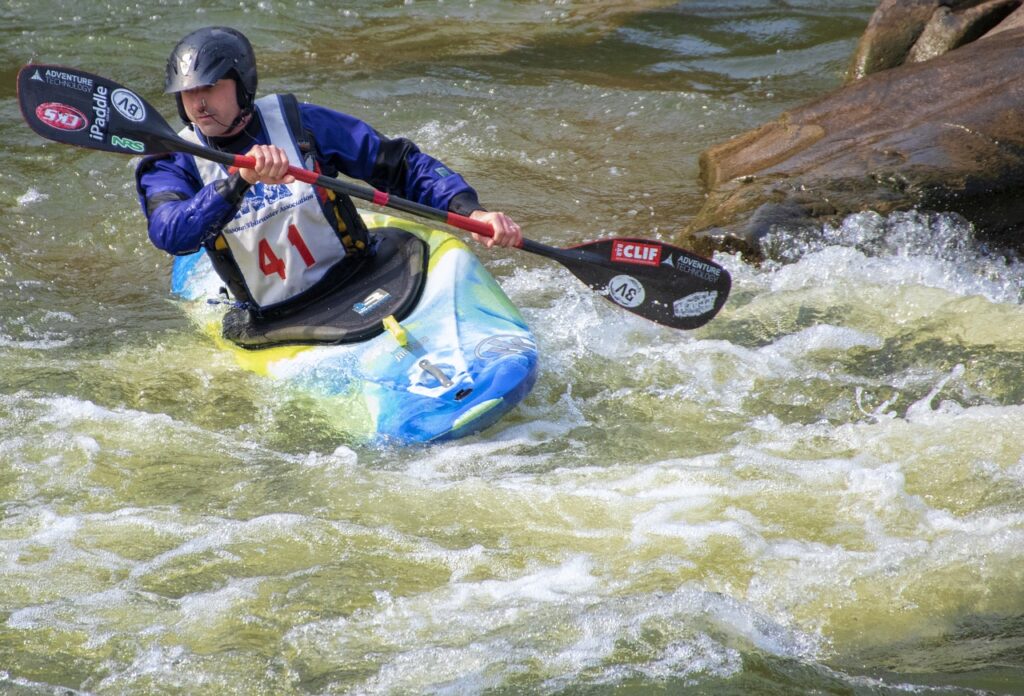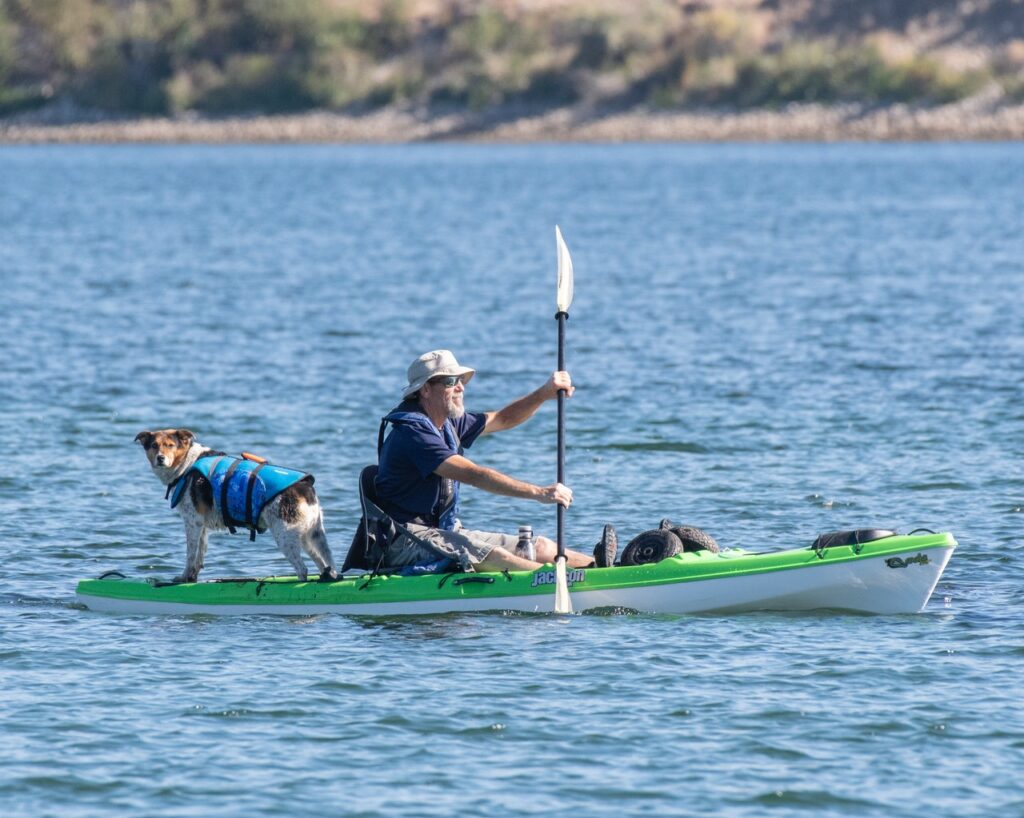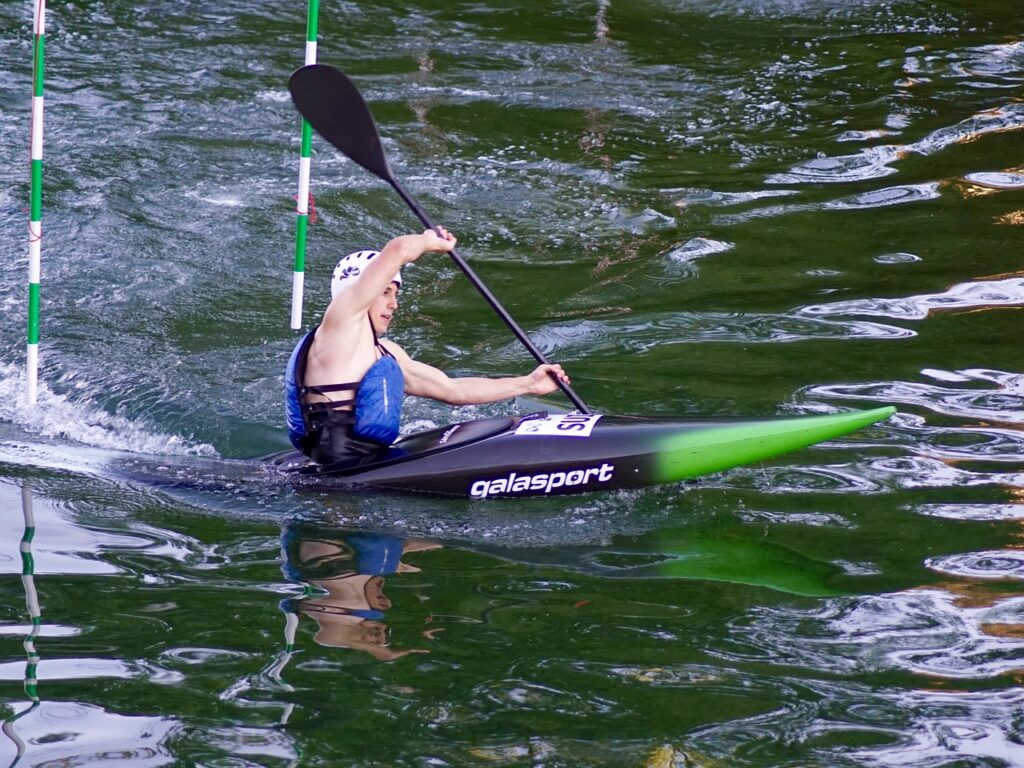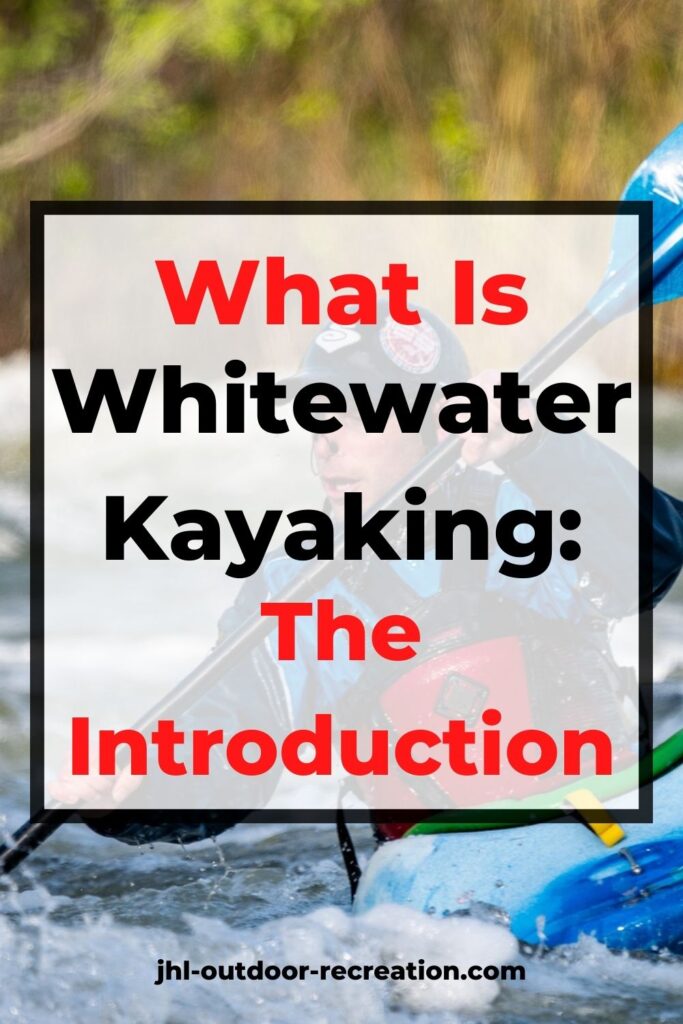There is an interesting scenario. When we talk about kayaking, we think of the conventional flatwater kayaking. Some of us may even dunno what whitewater kayaking is about. – It’s just natural and intuitive.
We picture ourselves kayaking under a sunny day. We are wearing a hat and a pair of sunglasses, paddling on a lake or calm water.
Whenever we feel tired, we stop paddling for a while and lean our back on the kayak, take a deep breath and observe the surrounding under the warmth of the sunlight…
Don’t you agree with that?
However, this doesn’t apply to whitewater kayaking. While some people have heard of it, some people DON’T.
So, this post is about the basic introduction to whitewater kayaking to give the general idea to the general.
Basic of Whitewater Kayaking

1. What is whitewater kayaking?
As the name suggests, it is where the kayakers paddle on WHITEWATER.
Let’s understand this. There is fast flowing water flow on the RAPID where there is change of gradient. This results in generating turbulence.
As water flows through this section, it hits the rocks or other obstacles. This forms water splash. The water splash creates white air bubbles. – Hence, it’s called whitewater.
2. What are the similarities with flatwater kayaking?
Whatever you have learnt in flatwater kayaking, you can also apply them in whitewater kayaking. Let’s look at some similarities between these two types of kayaking.
2.1 Paddle
In flatwater kayaking, you know the different types of paddle, ie. feathered and unfeathered paddle.
Furthermore, to hold the paddle properly, place the paddle above your head and form 90 degree on your elbows.
Both are exactly the same for whitewater kayaking.
2.2 Stroke
For both types of kayaking, the main navigation strokes are also the same.
Forward stroke – Paddlers immerse the blade in the water and draw the stroke backward to create FORWARD motion. Paddle on both sides.
Reverse stroke – Reverse of forward stroke. Paddlers immerse the blade in the water and draw the stroke forward to create BACKWARD motion. Paddle on both sides.
Sweep stroke – Similar to forward stroke. Instead of drawing the stroke backward, the paddlers draw an arch or semi-circle on one side to turn the kayak to the other side. The paddlers can also perform REVERSE SWEEP stroke by “modifying” the reverse stroke accordingly.
Draw stroke – Paddlers immerse the blade in the water, so that the blade is facing the kayak. Then, the paddlers pull the paddle so that the kayak moves towards the blade.
It is important to notice the subtle difference though. In flatwater kayaking, forward stroke is the main stroke. In whitewater kayaking, mastering all the strokes above is necessary for the navigation on the river.
2.3 Safety measure
Putting on a Personal Flotation Device (“PFD”) is necessary for both types of kayaking. In fact, we can attach a whistle on the PFD.
Get to know what to do in the event of capsizing for flatwater kayaking? The same exactly applies to whitewater kayaking. Wet Exit drill allows ourselves escape from the flipped kayak.
2.4 Others
There are other similarities which we should also appreciate them, such as
- Wearing for water, not for weather
- Sitting straight while paddling
- Never ever paddle alone
3. What are the differences with flatwater kayaking?

Apart from the similarities, there are some significant differences between them.
3.1 Concern
Paddling on turbulent water is totally different from paddling on calm water.
When we are paddling on calm water, the navigation is not influenced by other factors, unless there is strong wind. So, our main concern is to navigate the kayak forward in a straight line. – It is a perfect recreational activity.
When we are paddling on turbulent water, however, the navigation is influenced by many factors, such as the current of water, rocks, eddy, etc. This can cause the kayak move in any directions.
Thus, it is very crucial for the paddlers to know how to navigate the kayak properly. – Though this can be recreational in nature, it is more appropriate to classify it as an adventurous activity.
3.2 Additional essential skills
Because of its nature, additional essential skills are crucial for proper safety measure and navigation.
Bracing – While leaning their bodies to one side, the paddlers hit the water with the paddle, to create a temporary support. This allows the paddlers get back to the stable position. There are two types of Bracing, such as Low bracing and High bracing.
Bow rudder – The paddlers dip the paddle on either side of the bow of kayak to turn the kayak without losing the speed. The paddlers, however, need to perform this when the kayak is moving forward.
Wet Exit drill – A technique where the paddlers paddle on a sit-inside kayak with a sprayskirt. This technique allows the paddlers escape from the flipped kayak without drowning.
Roll-over technique – This technique allows the paddlers to roll the flipped kayak to its original position. There are 2 variations of this technique, namely C–To-C Roll and Sweep Roll.
The above skills are important in flatwater kayaking, but paddlers might OVERLOOK the skills because of the technical difficulty in learning.
For whitewater kayaking, the paddlers must LEARN and MASTER the above skills, even for beginners.
3.3 Headwear
Paddlers always wear a hat and sunglasses while paddling on flatwater. However, you rarely see paddlers wearing them while paddling on whitewater.
In fact, paddlers wear helmet while whitewater kayaking. This is an essential gear to protect the head while paddling.
Of course you have to wear a helmet, don’t you? There are so many rocks, tree branches, rapids, which can easily injure the head……
Never ever go whitewater kayaking without a helmet. If so, you are inviting TROUBLE.
3.4 Others
Other differences which are worth mentioning include:
- Types of kayak
- Self-taught vs having a proper lesson – While it is possible to learn flatwater paddling on your own, never ever do this for whitewater kayaking.
- Capsizing – it is way more common than flatwater kayaking.
4. Is whitewater kayaking suitable for beginners with no experience?
Yes, of course! If otherwise, how would you expect the paddlers become experts? – Even the experts were beginners.
While it is perfectly OK if you want to learn flatwater kayaking on your own, you will rarely, if never, see people recommend learning whitewater kayaking on your own.
Why? The above has already provided you some hints on this.
This is not about merely moving in a straight line, but also about managing and navigating the kayak under harsh conditions, such as capsizing, moving downstream, moving upstream, etc.
Meaning, the level of expertise and skill required are much higher than flatwater capsizing.
All you need to do is to SIGN UP for proper whitewater kayaking lessons.
Well, even if you transit from flatwater kayaking, you should also consider signing up proper whitewater kayaking lessons as well. The condition of paddling is totally different. – Simple as that.
However, as you are able to leverage the skills from flatwater kayaking, you can speed up your learning progress.
5. Is whitewater kayaking suitable for kids?
This is the same question as whether it is suitable for beginners as well. Yes, because nothing can hinder a kid from learning whitewater kayaking.
Let’s check out the experience of the Claudia Kerckhoff-Van Wijk, 10-time Canadian whitewater kayak champion, so you have better understanding on this for kids.
Okay. You might be reluctant to let your kids learn it because you don’t want your children paddle on the strong current and turbulent water like SLALOM in the Summer Olympic Games.
In fact, there are several grades for whitewater (which we are gonna discuss in the following session). For learning purpose, your children will learn it on low-grade-whitewater river or even on calm water.
Well, let’s sign up for proper whitewater kayaking lessons for your kids, unless you are an expert in this field and confident in teaching. Or, you may even consider having the lessons with your kids. – Why not? You can have fun with your kids!
Let your kids learn it when they are ready and OK with that, especially they know how to SWIM.
6. How to read whitewater?
You go to rivers and check the rivers. Some rivers seem very calm and some seem very turbulent. – So, how do know whether it is suitable for kayaking or not?
You are right. There are many factors which impact the turbulence of water. For example, the gradient, flow and current of water, rocks or boulders, the width of the rivers, etc.
The greater the turbulence of water is, the higher the skills required to navigate. – Meaning, we need to learn how to read whitewater before we start paddling.
Reading water is like forecasting the weather, cause we might not able to “read” properly as there are so many factors contribute to the judgment.
Thankfully, there are some common whitewater grading systems for our references. The systems are also applicable for whitewater canoeing, rafting and rowing.
6.1 International Scale of River Difficulty
This is a rating system from American Whitewater Association. There are 6 classes within this system, i.e from Class I (Easy) to Class VI (Extreme and Exploratory Rapids).
The higher the class is, the greater the technical skills require to navigate the kayak.
For Class I, there are a few to none water waves or rough area and so no technical skill is required. – Suitable for beginners.
For Class VI, however, the water is very turbulent with huge waves, rocks, steep gradient, water falls, fast and strong current. It is unpredictable and extremely dangerous. – Whitewater paddlers rarely attempt rivers with this grade because any slight error can be fatal.
6.2 Whitewater Difficulty Scale
This system is adopted by International Canoe Federation and German Canoe Association. Similar to American’s International Scale of River Difficulty, there are also 6 degrees within this system, i.e. From WW I (Not Difficult) to WW VI (Limit of Navigability).
Again, the higher the class is, the greater the technical skills require to navigate the kayak. The assessment of the degree consists of the factors of VIEW, WATER and RIVERBED.
7. How many types of whitewater kayaking are there?
There are 5 types of it, such as:
7.1 River running
Classical and the most popular type. Kayaking on the river.
Yes. This is the backbone of whitewater kayaking. Because of that, the following types of kayaking have evolved from river running.
7.2 Slalom

The kayaker has to pass through the predetermined checkpoints.
Ironically, apart from the Canoe Sprint, Slalom is the only discipline available in the Summer Olympic for whitewater kayaking. – Not even river running.
There are two types of check points: green gates and red gates. For green gates, the paddlers need to navigate DOWNSTREAM. For red gates, however, the paddlers need to navigate UPSTREAM. When the paddlers accidentally touch the gates, they will receive 2-second penalty to the overall time.
In the slalom discipline, there are usually 18 to 25 gates. The grade of the discipline is usually between Class II to Class IV.
7.3 Creeking
This is a tougher and more extreme version of river running. Therefore, you can expect the paddlers paddle on the narrow river (perhaps), high gradient and strong current water, and sometimes even need to “jump” off the waterfall while kayaking.
7.4 Freestyle / playboating
As opposed to river running, the paddlers maintain their position on the “HOLE” of the river to perform certain moves or somersaults, such as flipping, looping, spinning and surfing.
This water sport is very similar to surfing, skating and performing stunt while riding a BMX bike.
7.5 Squirt boating
Squirt boating is similar to freestyle, as the purpose isn’t travelling from one place to another, but to stay on certain location.
Interestingly, the paddlers navigate the kayak in a VERTICAL position to perform various type of acts and moves, such as squirting, looping, Zero to Hero, etc. This makes the paddlers look like “dancing” in and on the water.
As a comparison, while kayaking is similar to swimming, squirt boating is similar to synchronized swimming.
8. Is whitewater kayaking dangerous?
This is a hard question to answer. In fact, it depends on your definition of “dangerous”.
What if I said it is safe? – You won’t believe it, right?
This is because it is a SUBJECTIVE question. Different people will give you different kinds of answers.
Instead of asking whether it is “dangerous” or not, I believe it is more reasonable to ask whether it is a risky activity. Then, yeah, it is RISKY.
But, you know many activities are risky as well, don’t you? For example, open water swimming is risking; rock climbing is risky; hiking is risky; and even crossing road is risky……
Why do people still go for open water swimming, rock climbing, or hiking? By the way, those recreational activities are very popular now. Does that mean the people do not think of their safety?
8.1 How do we manage the risk?
Whitewater kayaking inherently is a risky activity. So, we need to comprehend and learn the technical skills like mentioned above before we try it.
Understand your capability in managing the rough water and attempt the appropriate-grade water that suits your capability.
This report states that over a 6-year period from 2005 to 2010 on the New River and Gauley River, there were 205 injuries and 7 fatalities over 1 million commercial paddlers. – It’s up to your interpretation whether it is safe or not.
It also depends on your personality. If you are an adventurous person, it is a perfect activity for you. If you are risk averse, however, flatwater kayaking is your preference.
Final thought
The popularity is booming in recent years. While it is excited if we try whitewater kayaking, we have to understand the inherent risk of it.
It is not the same as running. It requires a lot of technical skills and safety awareness even for beginner level.
That is why it is important to have general idea about whitewater kayaking before we try it. We need to manage the risk even before we try it.
Relevant posts
